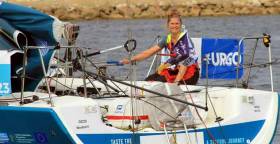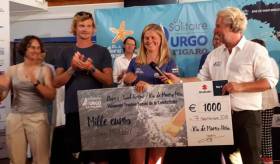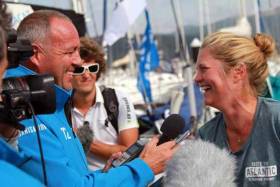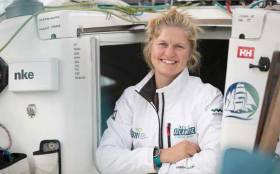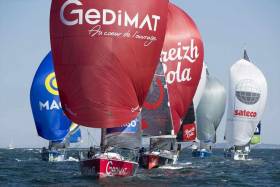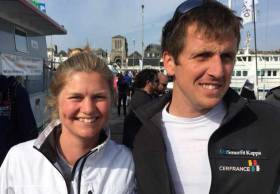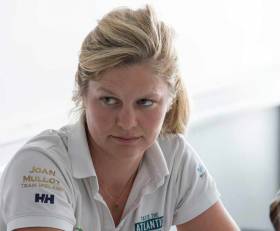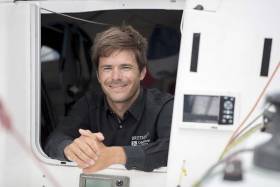Displaying items by tag: Joan Mulloy
Solo Sailor Joan Mulloy To Tell of Figaro Experience at Mayo Sailing Club
Joan Mulloy will be at Mayo Sailing Club Friday, the 5th October at 7 pm to give a presentation about her recent experience in the single-handed endurance Solitaire du Figaro race, her other sailing and her ambition to go all the way around the planet in the Vendee Globe Race.
All are welcome. Joan is a great Ambassador for Ireland and we are all very proud to have someone participating at the very top level of international sailing.
Admission is €25 adults and €10 Juniors/Students.
A taste of the Atlantic mussel dinner and a glass of wine “compliments of the Mulloy family” are included. There will also be an open bar.
All proceeds will go towards Joan Mulloy’s Yacht racing project.
Ireland’s Joan Mulloy Encouraged by Special Adversity Award from Spain as Figaro fleet Race Stage 3 Back to France
Joan Mulloy of Mayo overcame the setback of a broken main halyard to get back in the hunt in Stage 2 of the Solo URGO Figaro from Saint Brieuc in Brittany across the Bay of Biscay to Ria de Muros in northwest Spain, and on Friday – the fleet’s final full day in a Spanish port – her spirited approach was rewarded at an emotional ceremony with a special Adversity Award from the local community of €1,000 writes W M Nixon.
Yesterday’s start of Stage 3 back round Cape Finisterre and northeastward to Saint Gilles Croix de Vie on France’s Biscay Coast was delayed by local calms, and when the fleet finally got away it was to race a course shortened by 30 miles to make it 410 miles – straight to Ile d’Yeu, then the short hop to St Gilles, with the expectation of calms in the middle of Bay of Biscay dictating this distance reduction.
But off northwest Spain, once the breeze settled in it became the inevitable north to northeast wind which prevails at Finisterre in summer, and generally, the fleet kept in a close group with short tacks as each tiny curve in the coastline favoured one tack over another. However, off Corme early this morning, one group decided to take a more marked stab offshore, and it paid, so much so that fancied Scottish sailor Alan Roberts – usually a front-runner – found himself back in 35th position through staying inshore, and among those ahead of him was the reinvigorated Joan Mulloy.
Ireland’s Tom Dolan has been doing even better, finding good speed to stay with the offshore group, and as of 1430hrs this afternoon, the leaders are due north of Coruna, with Frederic Duthil on Technique Voile in the lead with 325 miles still to sail and a speed of 6.8 knots, while Tom Dolan is in 12th place, just 2.5 miles astern of Duthil, and for the moment marginally slower at 6.4 knots but though the morning he had been pushing 7.
Nevertheless the reality is that the entire fleet have been benefiting from the localised northeasters off Galicia – there’s a great big gap in the wind between their present location and Saint Gilles.
Rae tracker here
Solo Sailor Joan Mulloy 'Learning a Lot' in Gruelling Figaro Race
#ThisGirlCan has become a rallying cry for Joan Mulloy’s supporters in the Figaro Race writes Alex Blackwell in Galicia. After suffering a failed main halyard just before the start, which could have meant the end of the leg 2 for her A Taste of the Atlantic entry in the highly competitive and gruelling single-handed La Solitaire URGO Le Figaro Race, Joan returned to base, where her team managed to pull a new halyard through the mast in record time. She returned to the start and clawed her way back into the fleet, which had about a three hour lead on her.
The Second Leg of the URGO de Figaro required crossing the notorious Bay of Biscay – some 500 miles of strong tides, choppy seas and shifting winds through busy shipping lanes, from France to Spain. The fleet encountered a north-easterly air flow at about 20-25 knots which made for mostly downwind sailing.
 The Figaro fleet in port Photo: Alex Blackwell
The Figaro fleet in port Photo: Alex Blackwell
Three packs of sailors chose slightly different tactics. The two leaders from France, Sebastien Simon and Eric Peron, steered for A Coruna staying closer to the coast of Northern Spain, most likely hoping for a wind shift that would sling-shot them past the headland. Peron shadowed Sebastien much of the way. A second grouping heading straight for Finisterre experienced a wind shift forcing them to the west. A third grouping pointed yet farther offshore to avoid the fickle nature of winds at Finisterre, once thought to be the end of the earth.
The wind was forecast to die down to very little past Finisterre, with a slow upwind slog expected up the Ria de Muros y Noia in Galicia to Portosin. Maintaining speed as long as possible was the goal for the fleet. As evening closed in, it appeared that most of the racers would be finishing during the night when the substantial Galician fishing fleet was most active. Media representatives from France, Spain, Great Britain and Ireland settled in for a long night as the race marks for the finish were laid and the race village set up.
Near 3 am the tracking app showed that Sebastien Simon was still in the lead and approaching the finish line at the mole off the Real Club Nautico Portosin. Race officials, photographers and journalists raced off to intercept him as he tacked up the Ria to the finish. Simon crossed the line at 3:05:55, 20 minutes ahead of his rivals with an elapsed time of 2d 14h 05m 55s. Xavier Macaire managed to slip in front of Eric Peron for second place. Seconds separated the two in a gripping fight to the end.
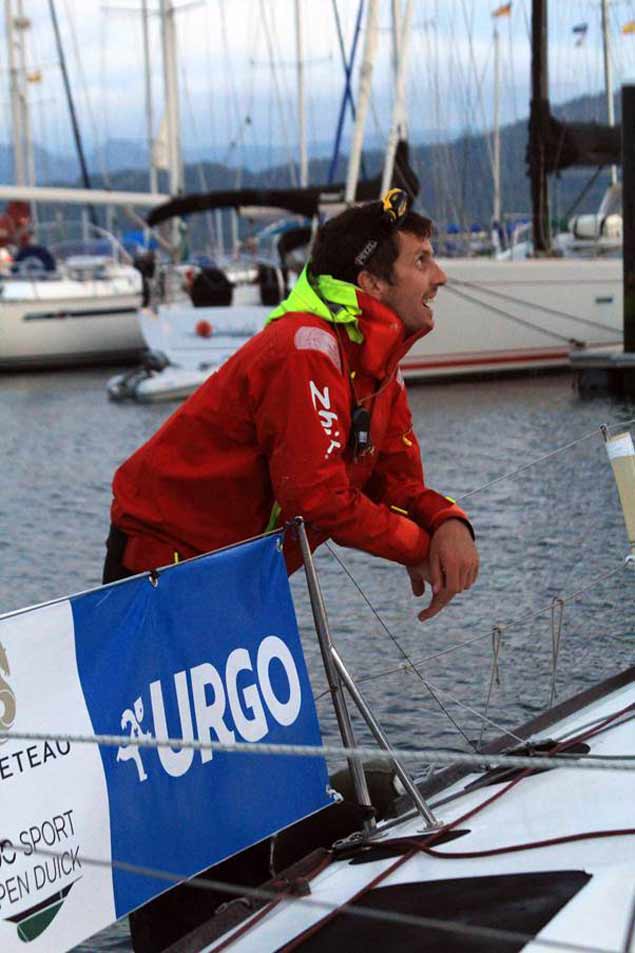 Tom Dolan at the end of stage two Photo: Alex Blackwell
Tom Dolan at the end of stage two Photo: Alex Blackwell
Meanwhile, Tom Dolan, the veteran Irishman in the race aboard Smurfit Kappa, played a consistent hand for much of the way. He finished as dawn was breaking in 25th place, with an elapsed time of 2d 17h 25m 10s. He had run out of water at some point, having consumed four litres shortly after the start of the leg, and was parched. All he asked for was water. A fellow competitor noted that that was the first time he had heard Tom ask for water after a race.
 Joan Mulloy finishes leg two in light winds Photo: Alex Blackwell
Joan Mulloy finishes leg two in light winds Photo: Alex Blackwell
Joan Mulloy’s Taste the Atlantic – A Seafood Journey finished at 9:53 in the morning in sunshine and gusty but light conditions. Her elapsed time was 2d 20h 53m 22s. Though exhausted, her grin said it all and she complied with media requests for interviews with a smile and plenty of insight. Asked what it felt like out there, Joan responded without hesitation, “I learned a lot in this race, mostly I learned a lot about myself.” She mentioned that dealing with the fickle conditions and lumpy seas was most challenging. She’d look at the weather forecast, see light air coming, have a bit to eat, then set the spinnaker, only to have the forecast change and she’d have to start all over again.
Joan has become quite the ambassador for BIM and Irish Seafood, a good proportion of which is exported to France. There was a good deal of media interest in her on the docks – particularly after her difficulties at the start. She has also become a major role model for young Irish women who sail and can see themselves in her shoes, plying the seas with the boys from France and Great Britain. #FirstIrishWoman. #Today’sGranuaille. Good natured, skilled, and well spoken, she’s an exceptional ambassador for Ireland overall.
If you want to follow our Irish racers, you can view the race tracker here. The race app, that can be downloaded from Apple and Google Play for Android, is totally addictive. It updates automatically every five minutes if left open. It’s like being out there with them in the cockpit making the calls. But it’s much drier.
Joan Mulloy Lying 27th After Two Legs of La Solitaire Le Figaro
Just seconds before the start of leg 2 in La Solitaire Urgo Le Figaro, Mayo’s Joan Mulloy suffered gear failure that saw her mainsail come crashing down. Luckily, the rules allow for outside assistance to make repairs before a certain point and she spent the remainder of the race playing catch up as the fleet raced across the Bay of Biscay towards Spain.
The setback put Mulloy 3 hours and 20 minutes behind the ultra-competitive fleet as they left the French town of Saint-Brieuc. Meath’s Tom Dolan on his yacht Smurfit Kappa stuck with the group for most of the race and finished in 29th place out of 36 largely French entrants. Mulloy clawed back two places and managed to finish 34th.
Speaking on arrival in Ría de Muros e Noia, Mulloy said, "I had to push really hard for the first 24 hours after the start because of the halyard problem. I had to pull in and get the halyard replaced. I did not sleep at all on the first night and just was chasing, chasing all the time. I was just thinking 'I can do it, I can do it, I can do it’. Every single bay and rock, I was just trying to squeeze the most out of everything. I was just totally determined to be with the pack before Biscay.”
Mulloy and Dolan are the only two Irish entrants in what is considered the most competitive offshore solo race series in the world. In France, it is a firm fixture for aspiring round the world racers with dreams of the Vendée Globe. The most experienced will dedicate years to La Solitaire Urgo Le Figaro before progressing to larger boats. Both Mulloy and Dolan are considered ‘Rookies’ as it is their first year competing.
Speaking about the Bay of Biscay Mulloy said: “Biscay was fine 30 knots (of wind) and bumpy, but I think all the time my mind was on Finisterre. It was hard not knowing how I was getting on with the rest of the fleet.”
After two legs Mulloy is lying 27th and Dolan is in 31st following his retirement in leg 1. Leg 3 of this 4 leg series starts on Saturday leaving just a few days for the fleet to recover. The next leg will see the fleet return to French waters ahead of the final leg, a 24 hours sprint that will bring this years event to a conclusion.
Joan Mulloy Makes Up Lost Places in Two-Part Figaro Fleet
Joan Mulloy, the first Irishwoman to take up the Figaro Solo challenge in France, has gained a couple of places racing Taste the Atlantic in the second day of Stage 2 to northwest Spain, after being delayed by a broken main halyard at the start off Sain-Brieuc writes W M Nixon. But Tom Dolan in Smurfit Kappa, having been up at 12th and within 1.5 miles of the leader, has slipped down the rankings through choosing to take the westerly option in the tricky waters between Ushant and the west coast of Brittany.
Anyone who has ever cruised this island-dotted, rock-strewn and tide-riven piece of the ocean will find it a marvel that people are racing single-handed through the midst of it with 36 powerful sailing machines under full spinnaker. But that’s part of the fascination of the way the Figaro race – now with the URGO organisation as co-sponsors - has developed as it works through the count-down towards its Golden Jubilee next year, when the third generation boats - foiling Figaro 3s - will be introduced.
Meanwhile, the Marc Lombard-designed Figaro 2 is centre stage in 2018 for the last time with style and nostalgia, and approaching the northwest point of Brittany at Lampaul early this afternoon, Gildas Mahe was leading. But he elected to continue offshore towards Ushant, while his closest challenger Anthony Marchand – the local hero after winning Stage 1 from Le Havre to his home port of Saint-Brieuc – gybed over to hold south down the coast.
The fleet had soon split into two distinct groups, and it was the inshore racers – led by Marchand and Pierre Leboucher – who did best, for as they have emerged into more open water well west of the Ile de Seine, the inshore group hold the first 15 places with its leaders shown as 5.2 miles clear ahead of the leaders of the offshore division, which included Tom Dolan with his placing now fluctuating in the 20s.
With winds steady from the northeast, progress is now more or less on rails, with any gains being fractional and hard-earned. The indications are that the mainly nor’east winds will continue across the Bay of Biscay. But the possibility of a low-pressure area developing over northwest Spain could make things more complex towards the finish, with a tricky beat into the Ria de Muros and up to the finish at Portosin being a final challenge for exhausted sailors.
Race tracker here
Joan Mulloy Delayed By Broken Halyard, Tom Dolan 12th After First Night of Figaro Stage 2
A broken main halyard at the start delayed Joan Mulloy’s departure yesterday in Stage 2 of the Solitaire URGO Figaro 2018, but Ireland’s other entry Tom Dolan is snapping at the heels of the top ten in this Stage, which started yesterday off St Brieuc in Northern Brittany and crosses the Bay of Biscay to northwest Spain writes W M Nixon. With fair mainly east to northeast winds off the French coast, the turning of the tide later favoured an inshore course , and the fleet are tacking to lee this morning off Brittany’s northwest corner, with Gilda Mahe (Breizh Cola) in the lead at Pointe de Pontuseval, 1.3 miles ahead of Stage 1 runner-up Charlie Dalin, and 1.5 ahead of Stage 1 winner Anthony Marchand back in third.
Tom Dolan’s current twelfth has him in close contact with top contenders such as Seabastien Simon (currently 7th) Hugh Brayshaw (8th) and Alan Roberts (5th). The first night has been a matter of catch-up for Joan Mulloy after her main halyard was replaced by her shore team, and she is further eastward along the coast, currently close west of the Ile de Batz and shown as 36th.
Race Tracker here
Joan Mulloy & Tom Dolan on RTE 'Seascapes' Tonight
Ireland’s solo Figaro sailors Joan Mulloy and Tom Dolan will be the focus of tonight's episode of RTE Radio 1’s Seascapes. Presenter Fergal Keane travelled to France to catch up with the skippers, teams, and sponsors ahead of leg 1 of La Solitaire Urgo Le Figaro.
On the show will be the two skippers, Ireland’s only ever entrant in the Vendée Globe and Atlantic Youth Trust President Enda O’Coineen, we’ll hear why Smurfit Kappa decided to sponsor Tom Dolan, and Team Ireland's Marcus Hutchinson will give an insight into this incredible race.
Listeners will also hear Joan Mulloy speaking on the dock at 3am after spending three and a half days alone at sea on her yacht 'Taste the Atlantic - A Seafood Journey'. The show airs at 22:30 on RTE Radio 1 and will be available online.
Joan Mulloy: 'A Wee Bit Disappointed' to Finish 27th in First Leg of Le Figaro Race
At 03:00am this morning, County Mayo’s Joan Mulloy crossed the finish line of the first leg of one of the most competitive solo sailing races, La Solitaire Urgo Le Figaro. Mulloy is the first Irish female to compete in this famous race. Mulloy placed 4th out of the 8 Rookies and 27th overall from 36. Speaking about her performance Mulloy said: “I am disappointed in the result a wee bit, but then you just have to look at what our goals were at the start of the year and where we are now, it is great to have been on the start line and now at the finish line.”
Speaking on arrival as she stepped off her boat ‘Taste the Atlantic - A Seafood Journey’, Mulloy said: “I’m totally zonked, the intensity, and the length of it. Three and a half days is a long time to constantly have your foot on the pedal. I loved it, I felt really well prepared, and we felt really well prepared as a team and I had fun!”
The gruelling three and a half day race started in the French port of Le Harve and finished off Saint Quai Portrieux in France. The fleet raced across the English channel battling 30+ knot winds only to be becalmed as the made their way towards a lighthouse off the southwest tip of England. 36 identical 32ft yachts crossed the starting line but the punishing conditions saw seven skippers forced to retire including Ireland’s Tom Dolan.
On Sunday Mulloy will be starting leg 2 of this 4 leg race. When asked what her priorities were during that time she said: “Sleep, have a bath and eat food!”
Leg 2 will see the fleet crossing the notorious Bay of Biscay to finish in the Spanish town of Ría de Muros-Noia 520 miles later.
Figaro First Stage Finish to be a Real Nail-Biter
The first shortened stage of La Solitaire URGO Figaro is speeding to a finish tonight off St Brieuc with less than a mile separating the leading dozen boats as they drag race along the rocky North Brittany coast in a welcome nor’west breeze. Alan Roberts of Scotland in fifth place is currently best of the non-French entries, but another helm from the Marcus Hutchinson stable, Hugo Brayshaw, is close astern in the tight-packed leading group.
Even though there are less than thirty miles to the finish and they’ve been hitting ten knots and better, it will be dark by the time they get to the line, and with the onset of evening, there’s a likelihood the breeze will ease. Currently, Anthony Marchand leads by 0.2 miles from Thierry Chabagny and Charlie Dalin, but the final downwind stretch will probably see another reshuffling of the pack.
Ireland’s Joan Mulloy has closed up on the leading group but is still 18.2 miles astern, making 9.2 knots in 27th place.
Race tracker here
Sudden Shortening of Course in La Solitaire URGO Le Figaro
This morning as the leaders in of La Soliatire URGO Le Figaro were approaching the southwest turning point of Stage 1 at Grand-Basse de Portsal off northwest Brittany, the Race Director informed them by VHF that he was shortening the course. Under the new instructions, they were no longer to complete 543 miles by racing to Saint-Brieuc by way of Guernsey, but instead were to race a total of 475 by going to the finish directly along the rocky and tide-riven north coast of Brittany reports W M Nixon.
Judging by some of the traces showing on the Race Tracker, two or three of the boats seem to be unaware of the change. But Alan Roberts, the Marcus Hutchinson-mentored Scottish sailor who first honed his skills in top-level dinghy racing, took on the fresh challenge with enthusiasm, and having been in or around third place for most of the cross-channel leg from the Wolf Rock, he went furthest inshore on the new beat, but on re-joining the main group, found he had slipped to 8th while Sebastien Simon once again has taken the lead.
Ireland’s Joan Mulloy, currently placed at 27th out of 36 starters, has still to pass the Portsal mark.
Race tracker with new course here


























